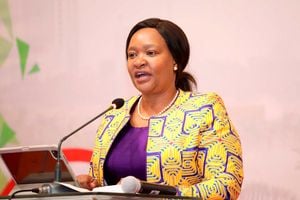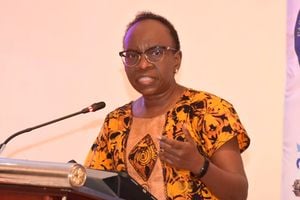
Controller of Budget Margaret Nyakang’o.
Salaries and allowances will take the lion’s share of the 2024/2025 budgets approved by a majority of the county assemblies.
Some devolved units have allocated more than 70 percent of their budgets to recurrent expenditure, leaving a meagre sum for development.
Controller of Budget Margaret Nyakang’o had earlier warned counties over their huge wage bills that continue ballooning.
In the County Governments Budget Implementation Review Report covering the first nine months of the 2023/2024 financial year, Ms Nyakang’o said that only Narok and Kilifi counties had capped their expenditure on wages at below 35 percent of the total budget.
She said that counties continue to spend more on personnel emoluments than what the law allows.
“The Public Finance Management Act, 2012 requires that at least 30 percent of the budget be allocated for development programmes. l urge counties to tame their growing wage bills. Most of the counties have had to deal with high wage bills gobbling up more than half of their annual budgets, hampering development activities. Most of the new governors have not been able to initiate development projects due to huge and ever-increasing wage bills,” said Ms Nyakang'o.
“There is a lot of wastage in the counties through bloated wage bills. Some counties use up to 75 percent of cash to pay salaries and only 25 percent is utilised for development,” she added in her report.
Unauthorised payments, over-staffing and unsupported payments have been cited as the main causes for the wastage in the counties.
Murang’a County Assembly Committee for Budget and Appropriation Chairperson Charles Machigo said last week that the assembly passed a budget of Sh10.46 billion for the 2024–2025 financial year. Out of this amount, Sh3.15 billion will go towards development, and Sh7.29 billion has been earmarked for recurrent expenditure.
Narok County Executive Committee Member for Finance David ole Muntet has tabled a Sh15.7 billion budget for the financial year 2024/2025.
He said that 34 percent of the money has been allocated to payment of employees’ salaries, 33 percent for operations of the county government and 33 percent has been set aside for development programmes.
Recurrent expenditure
In Kakamega, the county assembly has approved a Sh17.8 billion budget for the 2024/2025 financial year, in which recurrent expenditure received Sh11.9 billion, while Sh5.9 billion will be used for development.
In Migori County, Ward Representatives have endorsed a Sh10.386 billion budget for this financial year. Recurrent expenditure will take up Sh6.9 billion while development will be left with only Sh3.4 billion.
It’s a similar scenario in Trans Nzoia. The county assembly passed a Sh9.9 billion budget. The county has allocated Sh6 billion for recurrent expenditure and Sh3.9 billion for development.
In Taita-Taveta, MCAs have endorsed a Sh8.3 billion budget with recurrent expenditure consuming 67.4 percent of the cash.
Members of the County Assembly who contributed to the County Appropriation Bill, 2024 decried the huge wage bill which stands at 53 percent, which is above the approved 35 percent.
In Kiambu, Governor Kimani Wamatangi will use a big amount of the Sh23.5 billion budget on salaries and allowances.
In Nyeri, Sh5.8 billion of the Sh8.7 billion budget will go to recurrent expenditure, while Sh2.8 billion will fund development.
The amount set aside for development expenditure represents 33.04 per cent of the total budget, while recurrent expenditure accounts for 66.95 per cent.









